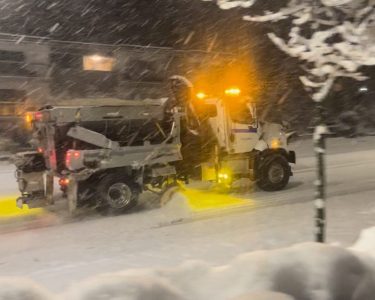The list of evacuation orders and alerts continues to grow as B.C.’s wildfire season is off to an early start, but the biggest risk is still in Fort Nelson as the Parker Lake fire pushes closer to the northeastern community.
As of Tuesday morning, the aggressive wildfire covered more than 84 square kilometres, up from 52 on Monday, fueled by gusty winds pushing it closer to town.
Thousands of evacuees are watching from afar but at least a dozen or so holdouts in the region are facing it first-hand, including Duane Loe who lives three kilometres south of Fort Nelson.
“We understand there are evacuation orders. They can’t force you out so we are here to protect our properties and our homes and the livestock. That’s why we are staying,” he told the Canadian Press on Monday.
Loe said he and others who have stayed are safe for now, adding they have food and water along with firefighting experience and equipment.
“The fire is still picking up and we have crews on the ground on our far side so we are just praying. We are just hoping for the wind to change to the east to blow the other way from the town. It’s in God’s hands now.”
That change in the wind is coming, according to CityNews meteorologist Michael Kuss, but not yet.
“We have to get through today. Winds are still mainly westerly and northwesterly as we head into the afternoon, and gusty, too. We still could see gusts pushing 50 kilometres an hour, so that’s tough for the firefighters,” Kuss said Tuesday morning.
“Things will change, though, heading into Wednesday, as winds get lighter and move more out of the east. That will push the fire back on itself. For Wednesday, Thursday, and Friday, at least, we should have that more easterly wind pushing the fire away from town.”
Kuss also predicts more cloud cover and higher humidity with a chance for light precipitation in the region over the longer range forecast.
While the Parker Lake fire remains the largest fire of concern in B.C., others are forcing evacuations, as well.
There were new wildfire evacuation orders and alerts issued for the small community of Doig River and the Doig First Nation about 60 kilometres northeast of Fort St. John in the northeast.
The regional district asked residents to grab what they need and go to an evacuation centre in Fort St. John, where help is waiting.
Northern Rockies Regional Municipality Mayor Rob Fraser says the municipality’s emergency operations centre called as many people as they had phone numbers for, and managed to convince some of the people who’ve remained to leave.
In southwestern BC, an evacuation alert has been issued for properties along the south side of Carpenter Lake west of Lillooet because of the Truax Creek wildfire.
Meanwhile, a fire in the northwestern part of Manitoba is singeing the community of Cranberry Portage and has forced about 550 residents from their homes, while a fire that’s prompted an evacuation alert in Fort McMurray, Alta., appears to be holding about 16 kilometres southeast of the city.
Alberta Wildfire says a blaze that has had 68,000 people in Fort McMurray on notice to be ready to leave at a moment’s notice since Friday grew yesterday when the sun came out and the humidity dissipated during the afternoon. Shifting winds also contributed to the growth “in multiple directions,” the agency said.
source: CityNews photo: BC Emergency Health Services





